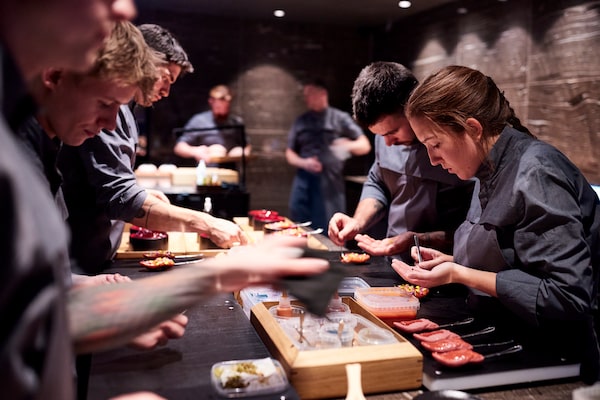
The team at Alchemist in the Danish capital of Copenhagen plates a dish. Rated among the world's best restaurants, it’s $1,000 for the fixed menu, rising to $3,000 with sommelier wine pairings.Søren Gammelmark/Supplied
I had butterflies in my stomach. Actually, just one butterfly. It tasted like kale.
Before explaining why I ate a butterfly in Denmark; before claiming that technology warps your memory; before suggesting that a moralistic restaurant for the wealthy might be a good idea, may I just say: Foodie culture is peculiar.
This fascination with the tongue-firing messages at its brain, while beslobbered gobbets slip down your gullet on a conveyer belt acting of its own accord, consummating experience by confiscating it, such that you’re left thinking, “What was in that?” And, if you paid enough, “What did it mean?”
My point is, I never got a table at Noma.
Do Quebec City restaurants deserve their own Michelin guide?
Confused about the rules of food & wine pairing? Follow these two guidelines instead
The oft-awarded “world’s best restaurant” shuts next year, and I missed out. On a recent visit to Copenhagen, I cycled to its roped-off entrance, confronting the painful reality: Never would I taste reindeer penis and go bankrupt in the same evening.
Mournfully, I pedalled away, stomach rumbling around the Danish capital. The city contains plenty of starry restaurants besides Noma. But local gourmands kept mentioning one place: Alchemist.
“It is the Star Trek of restaurants, going where no one has gone before,” a local foodie told me, smiling to add, “Half the food, I didn’t really like.” Yet she keeps returning.
I looked unlikely to go even once. It’s $1,000 for the fixed menu, rising to $3,000 with sommelier wine pairings. Even so, the waiting list can run to 1,000 people a night. The meal lasts around five hours, featuring 35 dishes (“impressions,” they call them).
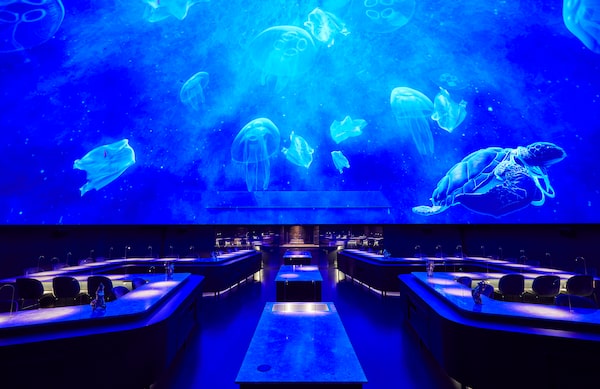
The planetarium dome at Alchemist.Søren Gammelmark/Supplied
Nervous first dates are strongly discouraged.
“It’s not a place you go to socialize,” the influential chef Ferran Adrià told Forbes magazine. “Alchemist is a place where you can reflect on our limitations as humans, both physically, emotionally and spiritually.”
Reservation or not, I had to get in.
A Guilty Pleasure
On my rental bike, I rattled into Refshaleoen, a former industrial zone on the Copenhagen waterfront once devoted to ship-building, now known for startups, contemporary art, paintball.
Alchemist inhabits a sprawling warehouse there, where the Danish National Theatre formerly built sets – fitting for a restaurant that conceives of dining as drama, selling “tickets” rather than reservations.
The restaurant’s “scriptwriter,” Lena Ilkjaer, agreed to simulate that evening’s performance (without the food). You enter by vast bronze doors, whereupon Scandi-suave staff greet you as cool equals, leading you toward Act One, a mirror room where a performance artist lunges around, dancing about “identity.”
You’re handed a tiny mirrored tile, the first taste of the evening. It’s your reflection, paper-thin. Self-image tastes of sugared apple, I’m told.
“Act One is supposed to take them out of their normal ordinary lives, and shake them up, and make them ask themselves: ‘Am I walking into a restaurant? What is this?’ ” Ilkjaer said.
Shutters clattered upward, releasing us from the claustrophobic mirror room into a lush lounge – fine dining at last, with a glassed-in cellar as high as one could see, and a glimpse of the test kitchen, where gastro-experimentalists sniffed and tasted frowningly.
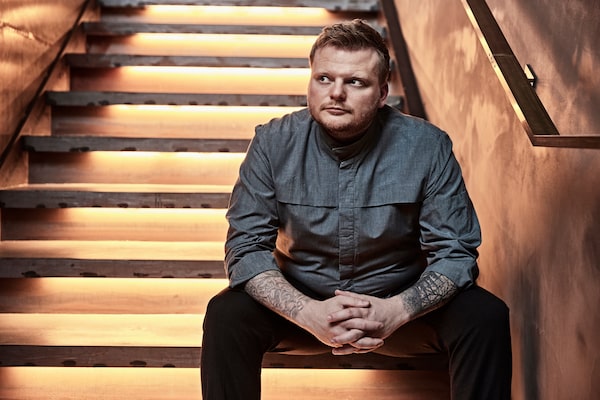
Rasmus Munk, Head Chef and co-owner, opened the new Alchemist in 2019 to ecstatic reviews, and the restaurant has gone on to rank among the world's best.Søren Gammelmark/Supplied
Act Two reassures diners that they will enjoy this – but not without disquiet. Among the “impressions” is Greed, a frozen apple/marigold foam that dissolves as you eat it.
Act Three is where most of the swallowing occurs, under a planetarium dome projected with animated images, such as a swaying coral reef. While you consume and consume, the coral above you dies, leaving garbage and Lego bricks in the sea. And now, for your next impression…!
This could be Plastic Fantastic, grilled cod jaw brushed with smoked marrow and topped with Comté cheese, covered in edible “cellophane,” and served on a see-through plate crammed with plastic rubbish.
To conclude Act Three is a candy bar called Guilty Pleasure, filled with mango jam, peanut gianduja, salted caramel. When you tear off the wrapper, the bar is shaped like a coffin, referring to child exploitation in the chocolate industry.
Dabbing your immoral lips, you are led to Act Four, a ball pit, as for kids at Ikea. The sound system blasts George Michael:
I won’t let you down (Freedom!)/ So please don’t give me up (Freedom!)
Some dive in, flinging balls, yowling and giggling. Eventually, staff members coax everyone upstairs for Act Five, a final few nibbles with coffee.
Diners here often burst into tears. And not just when the bill comes.
The Glutton’s Guilt
Gastronomy like this is not merely about food. It’s an event, akin to an unforgettable concert, or a leap from a propeller plane – if sky-diving weren’t whooshing past pigeons but feasting on them in brown butter.
This is haute-cuisine for an era when everything already blares onscreen for free: all the songs ever; all those words scrolling for your attention; all the clips of strangers sobbing, snarling, stripping.
This worldwide peepshow could make anyone feel ordinary and excluded. You detect this in the panics over FOMO (fear of missing out), and the chatter about bucket lists. First-hand experience has become a luxury good.
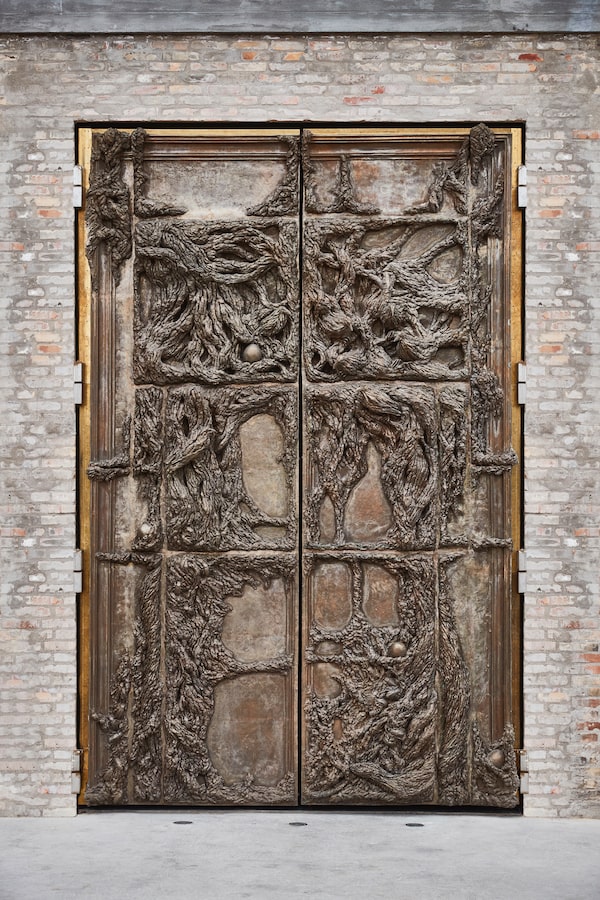
Guests enter Alchemist through two bronze doors created by Danish artist Maria Rubinke. The piece is called I found myself within a forest dark, while the doors are 13 ft tall and 8 ft wide.Claes Bech Poulsen/Supplied
Yet, when faced with a special event, we’re often reluctant to simply experience it. Attend any firework display, and look around: screens pointed skyward. We must save it, thus we miss it. Or, in culinary terms, you can’t have your cake and eat it too. So you photograph the cake.
The appetite for real-life experience brings a further problem. How to indulge when the world is burning precisely because of human indulgence? The foodie scene embodies this dilemma, whiplashing between “Forget tomorrow!” decadence (charcoal-smoked A5 Wagyu Kobe steak painted in gold leaf) and “Can’t forget tomorrow!” shame (Eat insects, or the planet dies).
The cunning of Alchemist is to feed diners their own manic-depressive mood, as when the waiter presents a metal cage containing chicken’s legs (including feet and claws), illustrating the nightmare of factory-farmed poultry. Diners then playact at freeing the limbs – which are stuffed with delectable soufflé.
It’s a gluttony-guilt emulsion. There is, however, another possible term: hypocrisy.
I put that to the chef.
Blood Bags
The meaty 32-year-old sipped his cortado, and he sighed.
“I’m worried about not succeeding with it,” Rasmus Munk confided. “Like, that I wake up in 10 years from now, 20 years, and I feel like I wasted my time. Could I have achieved more to be an activist? Or to study a little bit more, so I get more cultivated and more smart, and then go into politics. Could I use my time more wisely?”
I had not expected candour. The successful are rarely honest in public.
But Munk is a success who never expected it, a small-town boy from Jutland, son of a trucker and a nurse, whose only restaurant experience in childhood was the family trip to McDonald’s each Friday.
Young Rasmus stumbled into the kitchen. After a difficult ninth grade, he left the academic stream, joining a friend in culinary vocational training, working at a canteen for 300 blacksmiths. Next, Munk joined a Nordic restaurant in London. When he returned to Denmark, it was to an upscale restaurant called Treetop. Aged 22, he was head chef.
One Christmas, Munk volunteered to cook for poor families – just traditional grub. These eaters were so moved, far more than his posh clientele. The pursuit of gastro-glory lost appeal, and he quit.
When Munk returned to the business, it was his own, the first incarnation of Alchemist, a 15-seat eatery in the affluent Copenhagen neighbourhood of Osterbro. Typical of Munk’s creativity was a canvas and a selection of paints. Diners were invited to dab a picture – then eat it, “canvas” and “paint” included.
But his wider fame comes from a lamb’s heart, served with a “blood bag” of cherry sauce. Beneath the plate was a brochure: Have you signed up for organ donation? Alchemist enrolled 1,500 people, earning admiring press coverage. Munk saw again that cuisine could be more than just feeding the privileged.
In 2018, he published a manifesto, pushing away from the dominance of both New Nordic and Molecular Gastronomy. His concept was Holistic Cuisine, incorporating art, theatre, science and tech, alongside “debates on social and ethical issues.”
A wealthy Danish backer, Lars Seier Christensen, invested $20-million, and Munk closed the first Alchemist to plot a grander version. The new Alchemist opened in 2019, and reviews were ecstatic. In the latest “World’s 50 Best Restaurants” ranking, it soared to fifth – a stunning rise for such a young restaurant.
When I asked Munk of such glories, he maintained Danish humility. “This is a tool to make the other things happen,” he said.
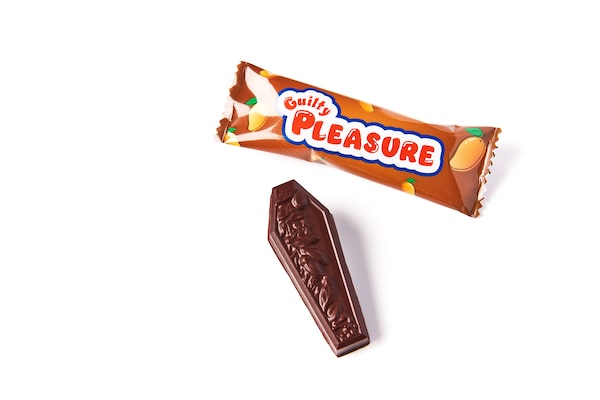
Diners are given a candy bar called Guilty Pleasure, which is filled with mango jam, peanut gianduja, and salted caramel. The bar is shaped like a coffin, referring to child exploitation in the chocolate industry.Claes Bech Poulsen/Supplied
Among those “other things” is hospital food. Could thrilling eating experiences improve patients’ health? If so, why not spread the idea worldwide?
Munk is working with a forthcoming kids’ hospital in Copenhagen to design food according to Holistic Cuisine, with young patients treated to dining “storylines” and spectacular tastes involving the senses. For example, Munk pondered nurses turning off the ward lights, and returning with a magical glowing cocktails (like those served at Alchemist), providing kids and their families with daily joys, rather than just daily distress.
Munk also started a project called JunkFood when the pandemic closed his restaurant, providing decent meals for the homeless. And he gathers findings from his test kitchen to lessen environmental damage, converting food waste such as the king-crab tail into something tasty enough that the industry might adopt it. Another project is his cultivation of edible butterflies, seeking a new sustainable protein.
“You have a voice,” he said. “And you can use it wisely.”
I had a voice, too, and it needed to say something. “Tell me if this is inappropriate,” I began. “But could I taste something?”
He presented a silver branch. Sitting atop: butterflies.
Just Desserts
This mess we’re in, dawdling on a roasting planet – is it because we’re in a lunatic spiral of self-pleasure, oblivious to tomorrow? Or is tomorrow the problem, that we’re doomed because human ambitions compel us to build mindlessly, hungering to carve our initials into a world we visit only briefly?
It’s both, I think. And that is our culture: everything and its opposite. Overeating but dieting. Reckless but fearful. Frantic but paralyzed.
Tomorrow keeps arriving so fast, long before we’ve digested yesterday. No wonder we crave something to clutch onto, a way to preserve today, to film and record and upload ourselves to the Cloud for safekeeping.
I’m swiping photos again, trying to remember the flavour. Crunchy kale? A hint of mayo?
Before tasting butterfly, I reached for the camera; I couldn’t resist.
Now, I’m here in the present, reviewing my past, struggling to summon that experience, asking a screen to recall my own life, before everything flutters away, out of control through the butterfly net.